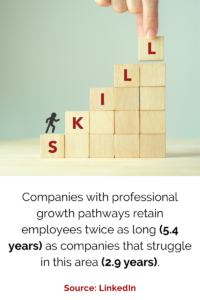Developing current talent is one of many ways organizations will bolster retention in the coming year.
By Zee Johnson
If The Great Resignation and The Great Reshuffle have taught us anything, it’s that employees will go where they feel most valued. In 2023 and beyond, companies that apply resources to current talent by actively upskilling, offering development opportunities, and challenging them professionally will drive the most loyal leaders.
LinkedIn’s Workplace Learning Report reveals that companies with professional growth pathways retain employees twice as long (5.4  years) as companies that struggle in this area (2.9 years). And by building this road to success, companies are supporting employee advancement while also closing the gaps that have lingered for too long. “Management and leadership development are essential to ensure that leaders are prepared for the future of work,” says Fiona Doyle, Senior Vice President – Talent Management at Cielo. “Companies need to consider how they can fast track the development of high potential individuals to fill key roles internally.”
years) as companies that struggle in this area (2.9 years). And by building this road to success, companies are supporting employee advancement while also closing the gaps that have lingered for too long. “Management and leadership development are essential to ensure that leaders are prepared for the future of work,” says Fiona Doyle, Senior Vice President – Talent Management at Cielo. “Companies need to consider how they can fast track the development of high potential individuals to fill key roles internally.”
Doyle shares how companies can actively support employees while developing their skills:
- Be purposeful. By intentionally upskilling talent, employers are combaing attrition, gaining the skills they need, and eliminating unnecessary costs. In fact, LinkedIn’s report finds that 79% of respondents say it is more cost-effective to upskill current workers than to hire new talent.
- Zero in on an approach. Many initiatives have proven to keep workers around longer, including those that focus on well-being and building internal communities to foster connection (DEIB groups, book clubs, and more).
- Put the employee at the center. Employees are more motivated to learn and develop new skills when it’s all about them. LinkedIn’s report finds that organizations will gain employee buy-in with learning opportunities if leaders help employees stay up-to-date in the industry; if learning is personalized to career goals; and if it improves the chances of promotion or internal mobility.
- Remain transparent. Keeping employees informed on business situations, especially during times of uncertainty, will instill trust and security.
Doyle says developing high-performing potentials can be a significant investment, given today’s economy, but is one with an even greater return. “As companies face some financial challenges, finding and retaining top talent will require extensive consideration into where to invest,” she says. “The past 12 months pushed the price of top talent into a new realm. Ensuring pay bands match the market will be key to success, both for hiring and retaining talent.”
For organizations that do invest in skills-building programs, there are many ways to measure the value of the initiatives. LinkedIn’s report finds the top tactics are getting qualitative feedback from employees through online courses, analyzing employee engagement survey scores, and obtaining manager feedback.
At a time when the talent market remains unpredictable, developing in-house talent who have already proven their ability to learn and evolve will be beneficial for both employees and employers of the future.














